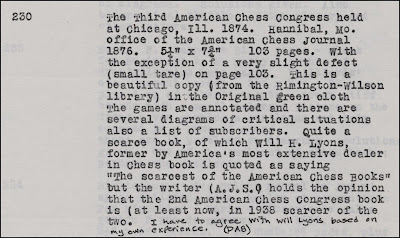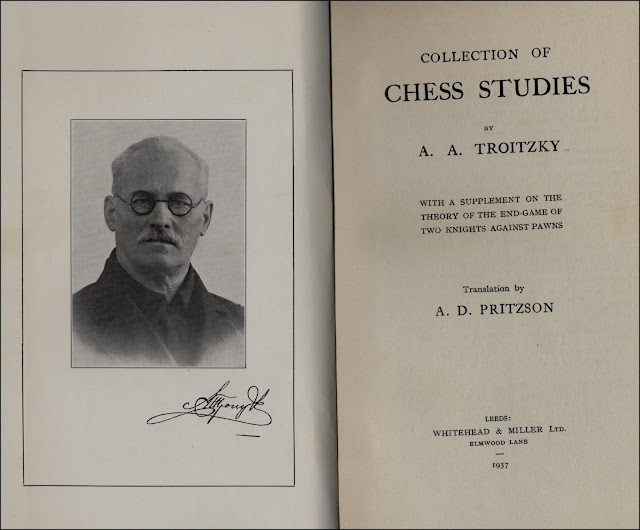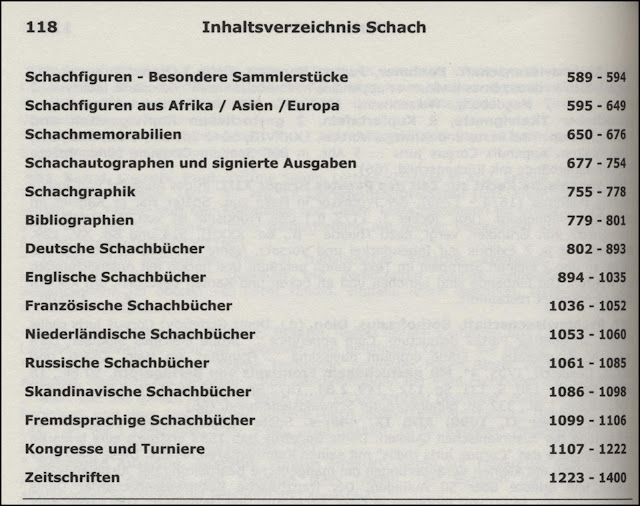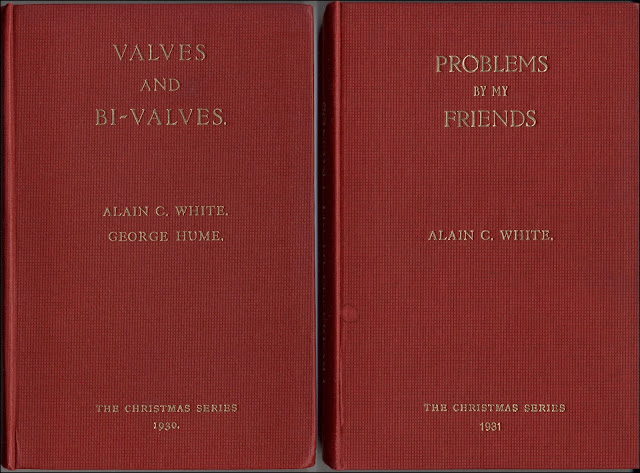Further Souweine observations on books in his library.
Marshall's Chess "Swindles", New York 1914: "This work is probably the most entertaining and useful of Mr. Marshall's chess books."
Renowned for his so-called "swindles", Marshall actually gave this book its title to hit back at some of his vanquished opponents who had derided Marshall's play following a loss. In his Introduction Marshall described himself "as the least bookish of all international players" and explained his book title as follows:
Another scarce collection of Marshall's games is Modern Chess in Championship Play, New York 1923. This book is not recorded in either Betts' Bibliography or the 1955 L/N catalogue. The book includes the games from Marshall's match with Edward Lasker in 1923 for the United States Championship (Edward Lasker covers this match at length and gives his viewpoint on the games in his book Chess Secrets, New York 1951), and Marshall's games from the ninth American Chess Congress held at Lake Hopatcong also in 1923.
Souweine comments "300 copies of this book have been printed from type and the type distributed. We understand that no copies of this book were offered for sale, but were used as prizes for the victors pitted against Mr. Marshall in simultaneous play." Most copies of this book are inscribed by Marshall.
Souweine comments "300 copies of this book have been printed from type and the type distributed. We understand that no copies of this book were offered for sale, but were used as prizes for the victors pitted against Mr. Marshall in simultaneous play." Most copies of this book are inscribed by Marshall.
The Book of the First American Chess Congress, by Daniel Fiske, New York 1859. "The sketch of the History of Chess and particularly "Incidents in the History of American Chess", and the Bibliography, makes this book of the greatest interest and importance to chess lovers."
Book of the Second American Chess Congress, held at Cleveland, Ohio, December 1871, Dubuque 1872. "This, one of the rather crudely printed Brownson productions, is probably the scarcest of the American Congress Books."
The Third American Chess Congress, held at Chicago, Ill. 1874, Hannibal, Mo. 1876. "Quite a scarce book, of which Will H. Lyons, formerly America's most extensive dealer in chess books is quoted as saying "The scarcest of the American Chess Congress Books", but the writer (A. J. S) holds the opinion that the 2nd American Chess Congress book is (at least now, in 1938) scarcer of the two. Dale Brandreth has added a note "I have to agree with Lyons based on my own experience".
Brandreth twice refers to the rarity of the Third American Chess Congress book in his pamphlet Collecting Chess Tournament Books - A Fascinating Hobby, published in 1977, but he excludes this from his list of the great classics in tournament books "on the basis that the competition was weak" (Mackenzie won ahead of Hosmer, Judd, Bock, Congdon and Perrin).
The Third is definitely the scarcer based on the frequency (or infrequency) with which it appears on the market and the prices obtained. However there is a complication in that some of the Second Chess Congress books have portraits pasted in of Max Judd and Theodore M. Brown making these copies more desirable and scarce.
The Book of the Sixth American Chess Congress, by Wilhelm Steinitz, New York 1891. "Without question the finest of the American tournament books."
Souweine's collection also included a little known pamphlet of 14 pages published in 1887 entitled To the Subscribers of the proposed American Chess Congress and to American players generally. This was issued in an effort to prevent Steinitz from becoming the editor of the proposed Book of the Sixth American Chess Congress "because of his previous vulgar writings in the International Chess Magazine."
Souweine had all six of Franklin K. Young's peculiar chess books and notes that his final work Field Book of Chess Generalship, New York 1923, is the scarcest of Young's books.
This is probably the most interesting of Young's works with a long introduction (albeit, riddled with errors) by A. B. Hodges, in which he gives brief details of the early history and literature of the game, before discussing Morphy, Pillsbury, Steinitz, Zukertort, Lasker and Capablanca. The book also includes a selection of games played by A. B. Hodges with critical [but normal] notes by Lasker, Steinitz, Gunsberg and Hodges.
Young starts the Preface to this book with a tacit admission that no one has understood a word of his previous five books:
But he immediately launches into his unintelligible babble-speak in the second paragraph:
However, the section on Hodges' games with annotations from Lasker & co. is perfectly readable.
Incidentally, the biography of Hodges by John S. Hilbert; Albert Beauregard Hodges: The Man Chess Made, published by McFarland in 2008, did not excite Nigel Short who had this to say at the end of an article on Rapid Chess on page 53 of New in Chess 2014-1:
Finally for now, Souweine had many of the Alain C. White Christmas Series of problem books including Retrograde Analysis by T. R. Dawson and W. Hundsdorfer, Leeds 1915, which he described as very scarce, and Roi Acculé aux Angles, Paris 1905, on which he observed: "This and the Robert Braune Collection are no doubt the scarcest of the A. C. W. books."
Many thanks again to Owen and Kathleen Hindle for use of their library and for many of these illustrations.
Book of the Second American Chess Congress, held at Cleveland, Ohio, December 1871, Dubuque 1872. "This, one of the rather crudely printed Brownson productions, is probably the scarcest of the American Congress Books."
The Third American Chess Congress, held at Chicago, Ill. 1874, Hannibal, Mo. 1876. "Quite a scarce book, of which Will H. Lyons, formerly America's most extensive dealer in chess books is quoted as saying "The scarcest of the American Chess Congress Books", but the writer (A. J. S) holds the opinion that the 2nd American Chess Congress book is (at least now, in 1938) scarcer of the two. Dale Brandreth has added a note "I have to agree with Lyons based on my own experience".
Brandreth twice refers to the rarity of the Third American Chess Congress book in his pamphlet Collecting Chess Tournament Books - A Fascinating Hobby, published in 1977, but he excludes this from his list of the great classics in tournament books "on the basis that the competition was weak" (Mackenzie won ahead of Hosmer, Judd, Bock, Congdon and Perrin).
The Third is definitely the scarcer based on the frequency (or infrequency) with which it appears on the market and the prices obtained. However there is a complication in that some of the Second Chess Congress books have portraits pasted in of Max Judd and Theodore M. Brown making these copies more desirable and scarce.
The Book of the Sixth American Chess Congress, by Wilhelm Steinitz, New York 1891. "Without question the finest of the American tournament books."
Souweine's collection also included a little known pamphlet of 14 pages published in 1887 entitled To the Subscribers of the proposed American Chess Congress and to American players generally. This was issued in an effort to prevent Steinitz from becoming the editor of the proposed Book of the Sixth American Chess Congress "because of his previous vulgar writings in the International Chess Magazine."
Souweine had all six of Franklin K. Young's peculiar chess books and notes that his final work Field Book of Chess Generalship, New York 1923, is the scarcest of Young's books.
This is probably the most interesting of Young's works with a long introduction (albeit, riddled with errors) by A. B. Hodges, in which he gives brief details of the early history and literature of the game, before discussing Morphy, Pillsbury, Steinitz, Zukertort, Lasker and Capablanca. The book also includes a selection of games played by A. B. Hodges with critical [but normal] notes by Lasker, Steinitz, Gunsberg and Hodges.
Young starts the Preface to this book with a tacit admission that no one has understood a word of his previous five books:
But he immediately launches into his unintelligible babble-speak in the second paragraph:
However, the section on Hodges' games with annotations from Lasker & co. is perfectly readable.
Incidentally, the biography of Hodges by John S. Hilbert; Albert Beauregard Hodges: The Man Chess Made, published by McFarland in 2008, did not excite Nigel Short who had this to say at the end of an article on Rapid Chess on page 53 of New in Chess 2014-1:
Finally for now, Souweine had many of the Alain C. White Christmas Series of problem books including Retrograde Analysis by T. R. Dawson and W. Hundsdorfer, Leeds 1915, which he described as very scarce, and Roi Acculé aux Angles, Paris 1905, on which he observed: "This and the Robert Braune Collection are no doubt the scarcest of the A. C. W. books."
Many thanks again to Owen and Kathleen Hindle for use of their library and for many of these illustrations.





























































